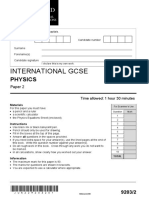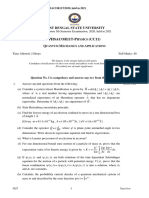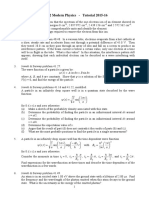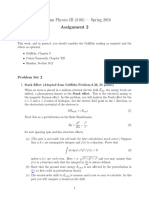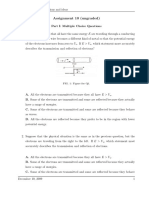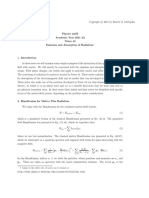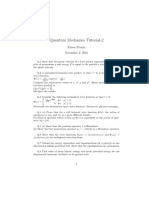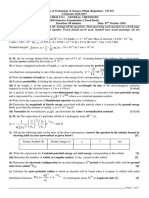2020 Cu QM
2020 Cu QM
Uploaded by
SuvangiOriginal Title
Copyright
Available Formats
Share this document
Did you find this document useful?
Is this content inappropriate?
Report this DocumentCopyright:
Available Formats
2020 Cu QM
2020 Cu QM
Uploaded by
SuvangiCopyright:
Available Formats
(1) T(5th Sm.
)-Physics-H/CC-11/CBCS
2020
PHYSICS — HONOURS
Paper : CC-11
Full Marks : 50
The figures in the margin indicate full marks.
Candidates are required to give their answers in their own words
as far as practicable.
Answer question no. 1 and any four from the rest.
1. Answer any five questions : 2×5
(a) The 2p state for hydrogen atom is known to be re r / 2ao (cos ) . Find out the expectation value of
r in this state.
d
(b) Find the eigenfunction and eigen value of the operator , assuming the eigenfunction to be single
d
valued in , i.e. f ( + 2) = f ().
(c) Prove that energy eigenfunction of free particle is doubly degenerate.
(d) In Stern Gerlach experiment why is it necessary to use a beam of neutral atoms and not of ions?
(e) What is Paschen Back effect?
(f) Explain why normal Zeeman effect occurs only in atoms with even number of electrons.
(g) Find out the magnetic moment of an atom in the state 2 D3 .
2
2. (a) Show that Fourier transform of a Gaussian wave function is also Gaussian.
px 2 1
(b) Consider a linear harmonic oscillator for which the total energy is given by E m2 x 2 .
2m 2
where the symbols have their usual meanings. The particle is assumed to be confined to a region a.
Use the uncertainty principle to obtain the minimum (ground state) of the oscillator.
(c) An electron of energy 342 eV is confined in one-dimensional box of length 1 A . Find out the quantum
number of the energy level of the electron and energy needed to excite it in the next higher level.
4+3+3
l l
3. (a) If a particle is confined between to , show that there will be two sets of energy
2 2
eigenfunctions depending on whether n is odd or even.
Please Turn Over
T(5th Sm.)-Physics-H/CC-11/CBCS (2)
Ax, 0 x a
2
(b) A particle in the infinite square well has the initial wave function ( x, 0)
A ( x a ), a 2 x a
Find (x, t).
(c) Find the quantum number corresponding to an oscillator of mass 2 gm, angular velocity 1 rad/sec,
amplitude 1 cm and using correspondence principle comment on its nature. 4+4+2
4. (a) Write down the Schrödinger equation for the electron of Tritium (H 3) atom, assuming the nucleus
to be stationary. Obtain the radial equation by separation of variables with special emphasis on
effective potential.
1
(b) The wave function of hydrogen atom is (r , 0)
10
2100 210 2 211 3 211
Find out the expectation value for the energy, L2 and Lz of this system. 4+(2+2+2)
5. (a) The wave function corresponding to the first excited state of a harmonic oscillator of frequency 0
2
is given by x Axex /2
; m0 / . Sketch x and determine A.
(b) Find the expectation value of the operator xpx in this state.
1 2i
(c) Find Sˆz in the state = A . (1+2)+4+3
2
6. (a) Write down the fine-structure formula mentioning each correction term with respect to the Bohr
energy for hydrogen atom.
(b) Using first-order perturbation theory, obtain the relativistic correction term to the kinetic energy.
(c) Find the g-value for 3S1 and 3P1 energy levels. Draw the schematic diagram of various allowed
transmissions between the above levels due to anomalous Zeeman effect. 3+3+4
7. (a) For normal Zeeman effect of hydrogen, explain how Lorentz triplet occurs. How are the and
lines polarized?
(b) The quantum numbers of two electrons in a two electron atom are
1 1
l1 = 3, S1 = 2 and l2 = 2, S2 = 2 .
(i) Assuming LS coupling, find the possible values of L and hence J.
(ii) Assuming JJ coupling, find the possible values of J. (3+2)+(3+2)
You might also like
- 9203 2 QP InternationalPhysics G 30may22!07!00 GMTDocument28 pages9203 2 QP InternationalPhysics G 30may22!07!00 GMTShaguNo ratings yet
- Quantum Mechanics Core 11 2020Document3 pagesQuantum Mechanics Core 11 20209153am735443No ratings yet
- Ps 9Document3 pagesPs 9Muskan BuraNo ratings yet
- S 5 - 34 - PHYSICS ndheYWDocument2 pagesS 5 - 34 - PHYSICS ndheYWrocksammi007No ratings yet
- CC111Document3 pagesCC111Zx̂'SkærNo ratings yet
- 8.321 Quantum Theory-I Fall 2016: Final Exam Dec 19, 2016Document4 pages8.321 Quantum Theory-I Fall 2016: Final Exam Dec 19, 2016bahadoor22i5583No ratings yet
- CC10 Quantum Practice QsDocument27 pagesCC10 Quantum Practice QsSuvangiNo ratings yet
- Homework (II) ForextrascoreDocument3 pagesHomework (II) Forextrascore張廷No ratings yet
- PHYS4216 TutorialsDocument5 pagesPHYS4216 Tutorialsnelkon7No ratings yet
- B.Sc. (H) Chemistry-5th Semester-2018Document15 pagesB.Sc. (H) Chemistry-5th Semester-2018Neha NegiNo ratings yet
- Assignment - V-PH (EE) 401 PDFDocument6 pagesAssignment - V-PH (EE) 401 PDFRajesh Kumar DasNo ratings yet
- Phys 415Document3 pagesPhys 415Joram MuiruriNo ratings yet
- Tutorial-2015-16 Modern PhysDocument6 pagesTutorial-2015-16 Modern PhysmirckyNo ratings yet
- Chennai Mathematical Institute PHD (Physics) Entrance Examination 2011Document3 pagesChennai Mathematical Institute PHD (Physics) Entrance Examination 2011Subhajit RoyNo ratings yet
- Advanved Quantum Mechanics Exam Freie Universitat BerlinDocument3 pagesAdvanved Quantum Mechanics Exam Freie Universitat BerlinjuanNo ratings yet
- Sem5 PHSH CC11Document2 pagesSem5 PHSH CC11questionwbcsNo ratings yet
- EP431: Semiconductor Physics: More Practice Problems..... : X y X yDocument7 pagesEP431: Semiconductor Physics: More Practice Problems..... : X y X yप्रियरंजन सिंह राजपूतNo ratings yet
- Atomic and Molecular Physics PH5410: Assignment 1Document1 pageAtomic and Molecular Physics PH5410: Assignment 1Suvashis MaityNo ratings yet
- SEMESTER-IX - Physics Questions - 2021-22 - AU PDFDocument8 pagesSEMESTER-IX - Physics Questions - 2021-22 - AU PDFRaunak AnjumNo ratings yet
- Tutorial 1 - To 4 AMPDocument4 pagesTutorial 1 - To 4 AMPKay r starNo ratings yet
- Folha 2 (5.)Document7 pagesFolha 2 (5.)Joao FernandesNo ratings yet
- Es 9Document1 pageEs 9NameorNickNo ratings yet
- Scan Jun 10, 2019Document6 pagesScan Jun 10, 2019Anonymous HKkF5YVCxpNo ratings yet
- Ps 6Document6 pagesPs 6SAYAN BAGCHINo ratings yet
- 4Document2 pages4Sathiyaseelan SankarjeeNo ratings yet
- Ex ExpPhys V WS2006 07ENDocument15 pagesEx ExpPhys V WS2006 07ENSatyam AgrahariNo ratings yet
- Paper On Quantum MechanicsDocument2 pagesPaper On Quantum MechanicsBiplab NeelNo ratings yet
- Chem Academy: Quantum ChemistryDocument3 pagesChem Academy: Quantum ChemistryHamit RanaNo ratings yet
- Ph501 Electrodynamics Problem Set 3: Princeton UniversityDocument32 pagesPh501 Electrodynamics Problem Set 3: Princeton UniversitykrishnaNo ratings yet
- Cuj AtomicDocument3 pagesCuj AtomicAman VermaNo ratings yet
- (Fall20) PYL101 MajorDocument2 pages(Fall20) PYL101 MajorAditya RoutNo ratings yet
- Amlp 2015Document6 pagesAmlp 2015bikramorigaonNo ratings yet
- P Electrons Using Briet's Scheme.: Dual Degree B. Sc. (Hons.) Physics-M.Sc. Physics EXAMINATION, May 2019Document3 pagesP Electrons Using Briet's Scheme.: Dual Degree B. Sc. (Hons.) Physics-M.Sc. Physics EXAMINATION, May 2019Vishal TanwarNo ratings yet
- Assignment 10 (Ungraded) : FIG. 1: Figure For Q1Document4 pagesAssignment 10 (Ungraded) : FIG. 1: Figure For Q1Arslan HassanNo ratings yet
- 2nd Internal Test BSC 2024Document3 pages2nd Internal Test BSC 2024lp eelceeNo ratings yet
- 1.0. Physics PYQ 2021Document1 page1.0. Physics PYQ 2021kunalrabidas2004No ratings yet
- 215 20010 11 hw2Document2 pages215 20010 11 hw2Oğuz RalphNo ratings yet
- Structure of Atom - QuestionDocument6 pagesStructure of Atom - Questionprakash bishtNo ratings yet
- 22.101 Applied Nuclear Physics: Fall Term 2009Document4 pages22.101 Applied Nuclear Physics: Fall Term 2009daniam_No ratings yet
- Department of Physics: Mid-Autumn Semester Examination-2015Document2 pagesDepartment of Physics: Mid-Autumn Semester Examination-2015asus89390No ratings yet
- 226 ELP 72 Student Copy KT01 6201 PDF Modern Physics EL JindalJi247Document2 pages226 ELP 72 Student Copy KT01 6201 PDF Modern Physics EL JindalJi247arorayash603No ratings yet
- Rollno. Anna University (University Departments) B.E. (Full Time) - End Semester Examinations, Nov/Dec 2021Document3 pagesRollno. Anna University (University Departments) B.E. (Full Time) - End Semester Examinations, Nov/Dec 2021hihelloNo ratings yet
- Gate 2018 PHDocument7 pagesGate 2018 PHPasupuleti AnilNo ratings yet
- RadnmattDocument22 pagesRadnmattjohann1685No ratings yet
- Subatomic Problem Set 1: Radioactivity and Nuclear StabilityDocument32 pagesSubatomic Problem Set 1: Radioactivity and Nuclear StabilityDiego M GranziolNo ratings yet
- Adobe Scan 22-Feb-2024Document14 pagesAdobe Scan 22-Feb-2024ssspd.entNo ratings yet
- Quantum Mechanics Tutorial For ScilabDocument2 pagesQuantum Mechanics Tutorial For ScilabAlphaNo ratings yet
- Chapter Antennas CharacteristicsDocument63 pagesChapter Antennas Characteristicsnesrine nesnesNo ratings yet
- t4 qm2 I 2024Document6 pagest4 qm2 I 2024Diego Rodrigo Uribe RodriguezNo ratings yet
- CHEM 221 Exam 1 2006Document3 pagesCHEM 221 Exam 1 2006Ian MillsteinNo ratings yet
- Atomic Structure - Practice Sheet - Arjuna JEE 2024Document3 pagesAtomic Structure - Practice Sheet - Arjuna JEE 2024armughank708No ratings yet
- USEFUL DATA: σ = 5.6697 a bx b x dx bx: e a r aDocument2 pagesUSEFUL DATA: σ = 5.6697 a bx b x dx bx: e a r aHarsh TiwariNo ratings yet
- Time Allotted: 3 Hrs Full Marks: 70Document6 pagesTime Allotted: 3 Hrs Full Marks: 70Vikash KumarNo ratings yet
- tutorial_1_4f3677eb-ab3e-497f-9717-0e5c9d326822Document4 pagestutorial_1_4f3677eb-ab3e-497f-9717-0e5c9d326822aravindkt2141No ratings yet
- Tutorial 1Document2 pagesTutorial 1Kushagra GuptaNo ratings yet
- Atomic Moleculer and Laser 2024Document4 pagesAtomic Moleculer and Laser 2024bikramorigaonNo ratings yet
- Sheet - 01 - Atomic Structure ExerciseDocument43 pagesSheet - 01 - Atomic Structure ExerciseMrinmay Dev SarmaNo ratings yet
- Sem IV - PHSH - CC9Document3 pagesSem IV - PHSH - CC9Anytime GamingNo ratings yet
- Good QuestionsDocument1 pageGood QuestionsCuriousNo ratings yet
- Problems in Quantum Mechanics: Third EditionFrom EverandProblems in Quantum Mechanics: Third EditionRating: 3 out of 5 stars3/5 (2)
- CastepDocument248 pagesCastepsamirayasmin1117No ratings yet
- Particle and Particle Systems CharacterizationDocument346 pagesParticle and Particle Systems CharacterizationAdriana AlmeidaNo ratings yet
- Radioanalytical ChemistryDocument481 pagesRadioanalytical ChemistrySD100% (2)
- Electron Ballistics EditDocument21 pagesElectron Ballistics EditGokul PvNo ratings yet
- 3 Inorg Org-Chemistry Edited Content-CompilationDocument115 pages3 Inorg Org-Chemistry Edited Content-CompilationKent TutorNo ratings yet
- Grup Two PresentiestionDocument23 pagesGrup Two PresentiestionFira tubeNo ratings yet
- CPhO 2018Document4 pagesCPhO 2018Gavin Birla100% (1)
- Bài Tập Vật Lý Đại Cương 2 - 23dvt - clc - hk2-Nh 2023-2024Document7 pagesBài Tập Vật Lý Đại Cương 2 - 23dvt - clc - hk2-Nh 2023-2024nndung.2k5No ratings yet
- 2 Exact Solutions To The Schrödinger EquationDocument1 page2 Exact Solutions To The Schrödinger EquationJack RyderNo ratings yet
- B.SC (H) V Quantum Mechanics and Its Applications I-6216Document6 pagesB.SC (H) V Quantum Mechanics and Its Applications I-6216Pooja SharmaNo ratings yet
- Research Paper of Atomic Emission SpectrosDocument8 pagesResearch Paper of Atomic Emission Spectrosxvszcorif100% (1)
- Important Questions of Motion in Straight Line and Motion in PlaneDocument33 pagesImportant Questions of Motion in Straight Line and Motion in PlaneBrijesh VermaNo ratings yet
- Report For Experiment On Gamma Spectroscopy of Bismuth-207 - Nida Riaz - Alfred Mishi - vf1Document28 pagesReport For Experiment On Gamma Spectroscopy of Bismuth-207 - Nida Riaz - Alfred Mishi - vf1Alfred MishiNo ratings yet
- (Download PDF) Classical Field Theory Horaƫiu Nastase Online Ebook All Chapter PDFDocument42 pages(Download PDF) Classical Field Theory Horaƫiu Nastase Online Ebook All Chapter PDFjudith.lara928100% (14)
- Physics: Daily Practice ProblemsDocument1 pagePhysics: Daily Practice ProblemsHarsh TanwarNo ratings yet
- Keith Conrad: N 0 N N 1 NDocument26 pagesKeith Conrad: N 0 N N 1 Nhgf2021No ratings yet
- Homework 6 SolutionsDocument5 pagesHomework 6 SolutionsYamkela Moise IINo ratings yet
- 03 KAnwar - AICOMSQ - QECC2022Document61 pages03 KAnwar - AICOMSQ - QECC2022alex02081991No ratings yet
- J Jcrysgro 2003 12 035Document15 pagesJ Jcrysgro 2003 12 035Magui Ros MonNo ratings yet
- Mit18 900s23 Lec1Document5 pagesMit18 900s23 Lec1Htike HtikeNo ratings yet
- 1 - Assignment - PH 401 (EE) - MODULE - 6 (Statistical Mechanics)Document2 pages1 - Assignment - PH 401 (EE) - MODULE - 6 (Statistical Mechanics)Cescesa CecepNo ratings yet
- Exercises 3.3: (A) of Value Include in Your SumDocument13 pagesExercises 3.3: (A) of Value Include in Your Summasrawy2010No ratings yet
- Thermodynamics - How To Explain The Maxwell Boltzmann Distribution Graph (Physically) ? - Physics Stack Exchange PDFDocument7 pagesThermodynamics - How To Explain The Maxwell Boltzmann Distribution Graph (Physically) ? - Physics Stack Exchange PDFKurt PatzikNo ratings yet
- ElectronicsObj Outcomes12021Document30 pagesElectronicsObj Outcomes12021khaleqNo ratings yet
- 3 Curvilinear Motion v4Document82 pages3 Curvilinear Motion v4JonathanNo ratings yet
- Class 12 Physics Magnetism and Matter PDFDocument4 pagesClass 12 Physics Magnetism and Matter PDFSumit WNo ratings yet
- Kinetic Theory of GasesDocument9 pagesKinetic Theory of GasesNorhazli IbrahimNo ratings yet
- Fan DesignDocument10 pagesFan DesignChandrashekhar Saraf100% (1)
- Faddeev PopovDocument5 pagesFaddeev PopovMarco OrnigottiNo ratings yet
